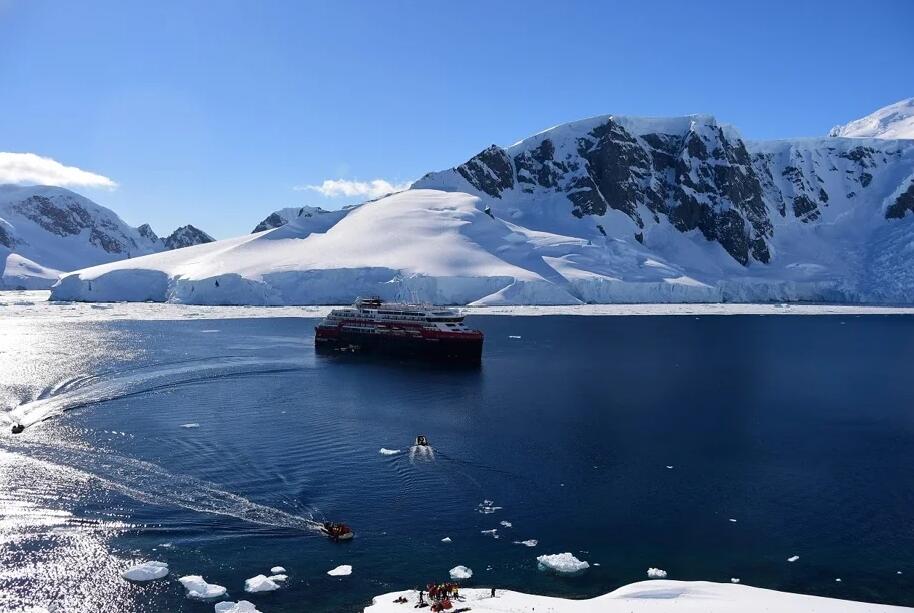(单词翻译:单击)
听力文本
New Discovery Suggests Antarctica Once Had Warm Rainforest
Today we know Antarctica as an extreme environment containing ice and snow. But new research provides evidence that the area was very different in the past.
The evidence was found inside a piece of Earth sediment collected by researchers from under the seafloor off the coast of Antarctica. In the sediment, they found forest soil estimated to be about 90 million years old. This would have been in the Cretaceous Period, when dinosaurs were the main land animals.
The sediment was removed by scientists on the research icebreaker RV Polarstern in the Amundsen Sea near the Pine Island Glacier.
Johann Klages is a geologist with the Alfred Wegener Institute's Helmholtz Center for Polar and Marine Research in Germany. He was the lead writer of a study on the findings, published in the journal Nature.
He said the sediment was collected from a depth of about 30 meters below the ocean floor. Klages said an examination showed that the material formed on land, not in the ocean.
The researchers estimate that the area – about 900 kilometers from the South Pole – had average yearly temperatures of about 12 to 13 degrees Celsius. During the warmest summer months, average temperatures likely reached between 20 to 25 degrees Celsius.
The average yearly temperature in that area is about 40 degrees below zero Celsius.
The examination process included the use of X-ray imaging technology. Those results showed "a dense network of roots that spread through the entire soil layer," the Helmholtz Center said in a statement. The condition of the soil was in such good condition that the researchers could see individual cell structures.
The dark brownish-gray soil included fine dirt particles and hard clay, as well as substances linked to at least 65 different kinds of plants, the study found.
"If you would go to a forest near you and drill a hole, it would probably look pretty similar," Klages told the Reuters news agency.
He added that the plants included trees, ferns and flowering plants. While no animal remains were found, Klages said there were likely dinosaurs, flying reptiles and many insects in the environment.
The research represents new evidence of the major climate changes Earth has experienced in the past - and is currently undergoing today. The soil dates back to the planet's warmest period of the past 140 million years, with sea levels about 170 meters higher than today.
The researchers said that the rainforest environment in Antarctica was especially surprising because each year, the area experiences a four-month polar night when there is no sunlight to fuel plant life. Klages said no ice sheets were present during the time, but seasonal snowfall was likely.
I'm Bryan Lynn.
重点解析
1.undergoing 经历
This powerful drug is used to tranquilize patients undergoing surgery.
这种强效药剂被用来麻醉手术病人。
2.temperatures 温度
The material requires higher temperatures and pressures to set hard.
这种材料需要有更高的温度和压力才能凝结变硬。
3.seafloor 海底
Abundant data and samples have been recovered by ocean drilling for studying the seafloor hydrothermal activity.
大洋钻探为海底热液活动研究提供了大量数据资料和样品。
4.seasonal 季节性的
Farm work is seasonal, so we must race against time.
农活有季节性,必须抢时间。
5.The research represents new evidence of the major climate changes Earth has experienced in the past - and is currently undergoing today.
climate changes 气候变化
If climate changes continue, we will suffer the consequences.
如果气候变化继续下去,我们将自食其果。
These animals became extinct because of climate changes and human activities.
由于气候变化和人类活动,这些动物逐渐灭绝了。
6.The research represents new evidence of the major climate changes Earth has experienced in the past - and is currently undergoing today.
in the past 过去
We did an analysis of the way that government money has been spent in the past.
我们分析了政府资金过去的使用情况。
The incidence of this disease has dropped considerably in the past few years.
近几年这种病的发病率大大降低了。
参考译文
南极洲9000万年前或为雨林
众所周知,如今的南极洲是冰雪覆盖的极端环境。但是新研究证实,该地区过去的环境并非如此。
研究人员从南极洲海底下采集到的一块地球沉积物中发现了证据。在该沉积物中,他们发现了估计有9000万年历史的森林土壤。那时可能是白垩纪时期,恐龙是当时主要的陆生动物。
极星号破冰船上的科学家们在松岛冰川附近的阿蒙森海钻取了这些沉积物。
约翰·克拉格斯(Johann Klages)是德国阿尔弗雷德·韦格纳研究所赫姆霍兹极地和海洋中心的地质学家。他是这项研究的主要作者,该研究发表在《自然》杂志上。
他说,这些沉积物是从海床以下约30米深处收集的。克拉格斯表示,经过检测证实,这种物质是在陆地上形成的,而不是在海洋中。
研究人员估计,这处区域距南极约900公里,过去的年平均气温是12到13摄氏度。在最炎热的夏季,平均温度可能达到20到25摄氏度。

该地区当前的年平均气温大约是零下40度。
检测过程包括使用X射线成像技术。赫姆霍兹中心在一份声明中表示,研究结果表明“密集的根系网络遍布了整个土壤层。”土壤的状况非常良好,研究人员能够看清单个细胞的结构。
研究发现,这些深棕色的土壤包含细小的淤泥颗粒和硬质粘土,以及至少65种不同植物相关的物质。
克拉格斯对路透社表示:“如果你到附近的森林钻一个洞,它可能看起来非常相似。”
他补充说,这些植物包括树木、蕨类和开花植物。虽然没有发现动物遗骸,但克拉格斯表示,该生态环境中可能有恐龙、会飞的爬行动物和许多昆虫。
这项研究为证实地球曾经历过且仍在经历重大气候变化提供了新的证据。这些土壤可以追溯到地球过去1.4亿年来最温暖的时期,当时的海平面比现在高出约170米。
研究人员表示,南极地区的雨林环境尤其令人惊讶,因为该地区每年都会经历长达4个月的极夜,期间没有阳光为植物生长提供能量。克拉格斯表示,这段时期该地区没有冰盖的存在,但是可能会出现季节性降雪。
布莱恩·林恩为您播报。
译文为可可英语翻译,未经授权请勿转载!


